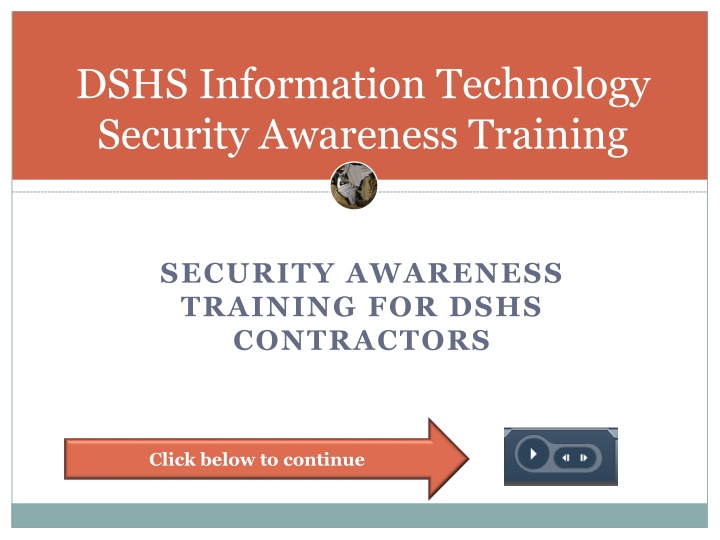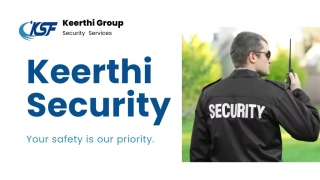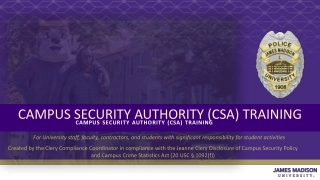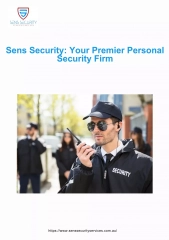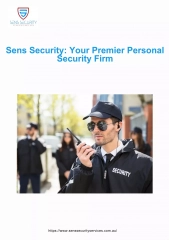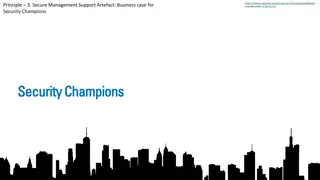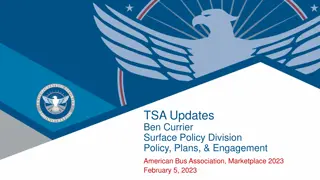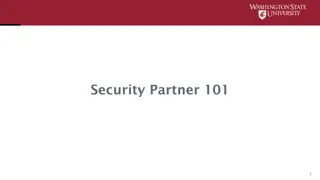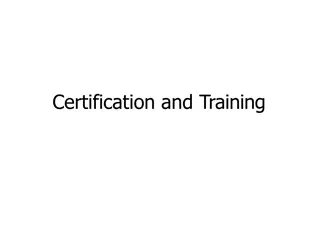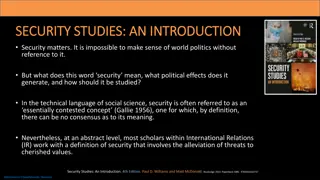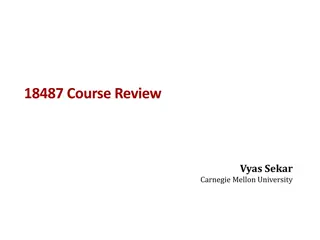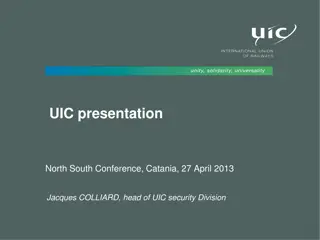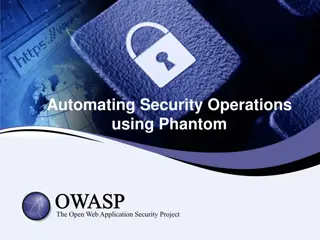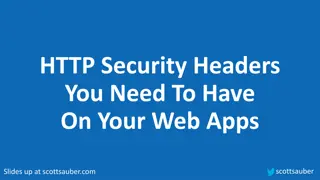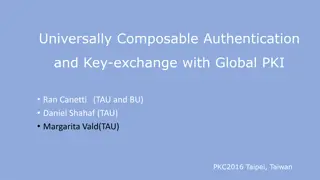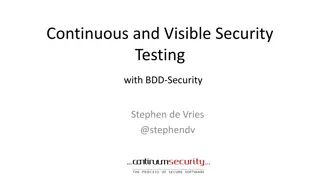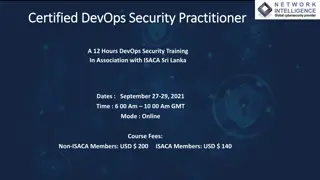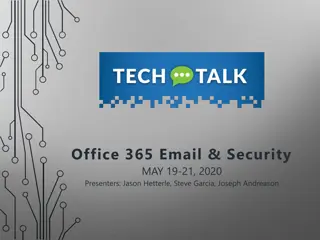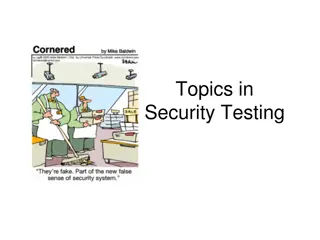DSHS IT Security Awareness Training
Welcome to the DSHS Information Technology (IT) Security Awareness Training. This course emphasizes the importance of safeguarding DSHS information and systems. Learn about your security responsibilities, why security is crucial for DSHS, and how to protect sensitive information. Complete the course, engage in quizzes, and enhance your understanding of IT security best practices.
Download Presentation

Please find below an Image/Link to download the presentation.
The content on the website is provided AS IS for your information and personal use only. It may not be sold, licensed, or shared on other websites without obtaining consent from the author.If you encounter any issues during the download, it is possible that the publisher has removed the file from their server.
You are allowed to download the files provided on this website for personal or commercial use, subject to the condition that they are used lawfully. All files are the property of their respective owners.
The content on the website is provided AS IS for your information and personal use only. It may not be sold, licensed, or shared on other websites without obtaining consent from the author.
E N D
Presentation Transcript
DSHS Information Technology Security Awareness Training SECURITY AWARENESS TRAINING FOR DSHS CONTRACTORS Click below to continue
Welcome to IT Security We are pleased to offer the DSHS Information Technology (IT) Security Awareness Training course. We know your time will be time well spent, and will benefit the department and our customers. All DSHS employees and contractors are required to take this course annually. To get credit for completing this course, you will need to notify your supervisor, human resources, or trainer once completed. There is no audio narration in the course. This course should take between 20 and 45 minutes to finish. Thank you.
Your security responsibilities start here... Lesson 1 Lesson 1: : Introduction Introduction to Security to Security Awareness Awareness Any DSHS employee or contractor may have access to information that needs to be protected. We are each responsible for its safekeeping. This course shows why and how each of us can protect and preserve DSHS information and information systems on a daily basis as we work. For additional information, click the links provided at the left side of the pages of this course.
Why is security important to DSHS? Various state and federal laws and regulations hold DSHS accountable for protecting information about its clients and employees. Violation of this trust can result in lawsuits and sanctions in the millions of dollars. Security Security Importance Importance Why is security important to you? You are responsible for safeguarding DSHS information and the computer systems entrusted to your care. Unauthorized disclosure of the department's information, or inappropriate use of the computer systems, may result in disciplinary action up to and including fines and/or cancelation of your contract.
Each lesson includes a series of questions. The questions are presented in Multiple-choice, True/False, or Yes/No format. Each question has one best answer. Yes, there Yes, there will be a will be a quiz! quiz! You can keep score of your selection for each question and count the number of correct selections you make, keep track on a separate sheet numbered 1-12. Please answer the sample question on the next page.
Lesson 1: Introduction to Security Awareness 1) Why is IT Security important to me? IT Security is already built within the system. IT Security is someone else s job. IT Security is not my problem. IT Security is my daily obligation. Lesson 1 Lesson 1- - Quiz Quiz
Lesson 1: Introduction to Security Awareness 1) Why is IT Security important to me? IT Security is already built within the system. IT Security is someone else s job. IT Security is not my problem. IT Security is my daily obligation. You are the initial point of entry for most viruses, malware, etc. so you must remain diligent. Lesson 1 Lesson 1- - Quiz Quiz
Lesson 2: Bogus Messages You may have seen bogus email messages (sometimes called spam or phishing messages) or bogus pop-up messages. They are designed to get you to click a link and/or provide information such as a password. Clicking could also infect your computer with a virus. Lesson 2: Lesson 2: Bogus Bogus Messages Messages
Common Questions How can I tell if a message is bogus? If I am not sure, who should I ask? If it is bogus, who should I tell? Common Common Questions Questions
How can I tell if a message is bogus? It is not always easy to tell, but here are some simple tips. 1. Read carefully any message that asks you to click a link, or to enter a password. 2. Is it an email that appears to come from someone you know? Would he or she normally send you a message like this? How Can How Can I Tell? I Tell?
How can I tell? (cont.) 3. Pop-ups or windows: Do you routinely see messages like this one? If not, have your computer support staff told you to expect a message like this one? Were you on a non DSHS web site when the message appeared? Does the message contain grammatical errors? How Can How Can I Tell? I Tell?
If I am not sure, who should I ask? If in doubt, talk to your supervisor, help desk, or computer support staff. Who Who Should I Should I Ask? Ask?
If I know a message is bogus, who should I tell? To report bogus messages attach the original of any bogus email message to a new message, and send it to your computer support staff. Who Who Should I Should I Tell? Tell?
Bogus MessagesConclusion Read messages carefully. If in doubt, talk to your supervisor, help desk, or computer support staff. Conclusion Conclusion
Lesson 2: Bogus Messages 2) What things should I look for to determine if an email message could be bogus? If it asks me to click a link or enter a password, read it carefully. Does it appear to come from someone I know, and would he or she normally send a message like this? All of the above Lesson 2 Lesson 2 Quiz Quiz
Lesson 2: Bogus Messages 2) What things should I look for to determine if an email message could be bogus? If it asks me to click a link or enter a password, read it carefully. Does it appear to come from someone I know, and would he or she normally send a message like this? All of the above Make certain the email looks and reads as genuine. NEVER send your password or enter personal information at a link. DSHS will never ask for this information via email. Lesson 2 Lesson 2 Quiz Quiz
Lesson 2: Bogus Messages 3) If I am not sure whether a message is bogus, I should talk to my supervisor, help desk, or computer support staff. True False Lesson 2 Lesson 2 Quiz Quiz
Lesson 2: Bogus Messages 3) If I am not sure whether a message is bogus, I should talk to my supervisor, help desk, or computer support staff. True False If you have any question about an email then contact your local IT help person or your supervisor. Lesson 2 Lesson 2 Quiz Quiz
This lesson explains: Lesson Lesson 3: Protecting Protecting Information Information 3: How you can protect DSHS information. Why protecting DSHS information is so important.
Why Protect Information? Personal information about clients and employees must be protected because: Our clients give us personal information to receive a service. They trust us to keep that information private--to not disclose that information except as needed to provide that service. Various state and federal laws require us to keep information private. State law requires us to notify persons whose personal information we have inappropriately disclosed. Admin Policy 05.01
Not all DSHS information requires the same level of protection. Classes of Classes of Information Information Managers are required to make sure that information entrusted to their care is classified according to the following four broad categories, and protected accordingly. "Public Information" can be released to the public. "Sensitive Information" is not specifically protected by law, but should be limited to official use only.
"Confidential Information" is specifically protected by law. It generally includes personal information about individual clients and employees. Classes of Classes of Information, Information, continued continued "Confidential Information Requiring Special Handling" has especially strict handling requirements. Some examples of "Confidential Information Requiring Special Handling" include: - Protected Health Information (PHI), as defined by HIPAA rules. - Information that identifies a person as a client of an alcohol or substance abuse treatment, or mental health program.
So, how can I protect the Department s Information? Protecting Protecting Information Information Store information in a safe place. Normally, you should save any files in your home directory (folder) or a shared directory (folder) on a server NOT on your Local Disk (C:) If you need to store confidential information anywhere else e.g. on your Local Disk (C:), flash memory device ( thumb drive ), or CD, you must: Have documented management approval; and Get instructions on how to protect the information (contact your computer support staff).
Protecting Information (cont.) Do not directly connect any employee owned device or recordable media to a computer or network. This includes: Smart phones. Flash memory devices ( thumb drives ). Writable CDs or DVDs.
Protecting Information (cont.) Protecting Protecting Information Information Do store paper documents containing confidential information in locked containers (e.g. file cabinets) after normal working hours. Do lock your computer screen whenever you leave it. Do not share confidential information with coworkers who do not need it to do their jobs.
Protecting Information (cont.) Protecting Protecting Information Information If you are authorized to send confidential information through e-mail messages over the Internet (i.e. outside the state/intergovernmental network) you must use a secure messaging process such as the DSHS Secure E-Mail Message system.
Protecting Information (cont.) Protecting Protecting Information Information Do immediately report loss, theft, or unauthorized disclosure of data in any form (e.g. paper or electronic) that potentially includes DSHS confidential information, to the ISSD Service Desk at 1-888-329-4773, 360-902-7700, or email ISSDservicedesk@dshs.wa.gov this includes data lost by contractors.
Sharing Sharing Information Information with with Business Business Partners Partners When DSHS shares confidential information with other entities (e.g. private contractors or other government agencies), there must be a formal contract that meets specific requirements. For details on sharing DSHS information, please contact your contracts staff.
Some DSHS information is protected by law. Federal Information Some DSHS information is protected under state and/or federal law. Social Security Administration (SSA) data is one such example. SSA client data is confidential. It s protected by RCW 74.04.060 at the Washington State level and by the federal Privacy Act of 1974.
Protected SSA data is defined as all personal client information obtained from or verified by the Social Security Administration. Federal Information, Continued SSA client data may be provided directly to the client or their representative. SSA data may only be disclosed to agencies or other individuals for purposes related to program administration after an individual data share for that individual or agency has been established with the SSA. When in doubt about whether or not you re allowed to disclose, ask your supervisor!
Employees are held personally accountable for the appropriate use of SSA client data. It must be handled and stored securely, never left out for others to see, and destroyed in a secure manner when no longer needed. Federal Information, Continued Unauthorized inspection, use, or disclosure of SSA client data can result in termination, prison time, and/or a fine of up to $5,000. If you suspect that SSA client data has been lost or breached you must report it to your supervisor immediately. (SSA requires that you report the incident within one hour.) The following slide explains how to report.
Any loss or breach of SSA client data must be reported to the United States Computer Emergency Readiness Team (US-CERT). A report must be filed within one hour. Federal Information, Continued In addition to filing a US-CERT report, any loss or breach of SSA client data must also be reported to the DSHS Privacy Officer. If you are unable to contact the DSHS Privacy Officer within one hour, call SSA s National Network Service Center (NNSC) toll free at: 877-697-4889 (Select Security and PII Reporting )
Lesson 3: Protecting Information 4) Which classification of data requires the greatest protection? Public Information Sensitive Information Confidential Information Confidential Information Requiring Special Handling Lesson 3 Lesson 3 Quiz Quiz
Lesson 3: Protecting Information 4) Which classification of data requires the greatest protection? Public Information Sensitive Information Confidential Information Confidential Information Requiring Special Handling This information includes personally identifiable health information, PHI, which is covered under HIPAA. Lesson 3 Lesson 3 Quiz Quiz
Lesson 3: Protecting Information 5) Before I save any files containing confidential information on my Local Disk (C:), a flash memory device ( thumb drive ), or CD, I must: Have documented management approval Have received instructions on how to protect the information Both of the above Lesson 3 Lesson 3 Quiz Quiz
Lesson 3: Protecting Information 5) Before I save any files containing confidential information on my Local Disk (C:), a flash memory device ( thumb drive ), or CD, I must: Have documented management approval Have received instructions on how to protect the information Both of the above In addition to management approval the information must also be encrypted. Lesson 3 Lesson 3 Quiz Quiz
Lesson 3: Protecting Information 6) I may save the following kinds of information on my home computer: Lesson 3 Lesson 3 Quiz Quiz Confidential client information Notes on a DSHS business meeting No DSHS information
Lesson 3: Protecting Information 6) I may save the following kinds of information on my home computer: Lesson 3 Lesson 3 Quiz Quiz Confidential client information Notes on a DSHS business meeting No DSHS information Never save any DSHS or client information to your home computer, even if it s just temporary.
Lesson 3: Protecting Information 7) I may plug or insert the following items, which I personally own, into my DSHS computer: Lesson 3 Lesson 3 Quiz Quiz A flash memory Device ( thumb drive ) A smart phone A writable CD or DVD None of the above
Lesson 3: Protecting Information 7) I may plug or insert the following items, which I personally own, into my DSHS computer: Lesson 3 Lesson 3 Quiz Quiz A flash memory Device ( thumb drive ) A smart phone A writable CD or DVD None of the above Personal devices, usb items such as lights or a cup warmer, or anything not specifically provided by your local IT may not be plugged into your DSHS computer. Not even to charge your cell phone or other devices.
Lesson 3: Protecting Information 8) When I leave my computer, I don t need to lock the screen because it locks automatically after 20 minutes: Lesson 3 Lesson 3 Quiz Quiz True False
Lesson 3: Protecting Information 8) When I leave my computer, I don t need to lock the screen because it locks automatically after 20 minutes: Lesson 3 Lesson 3 Quiz Quiz True False The 20 minute lock is only a backup in case you forget to manually lock when stepping away.
Lesson 3: Protecting Information 9) I can send confidential DSHS information in an e-mail to a contracted service provider, using my Outlook email account, because Outlook automatically encrypts messages. Lesson 3 Lesson 3 Quiz Quiz True False
Lesson 3: Protecting Information 9) I can send confidential DSHS information in an e-mail to a contracted service provider, using my Outlook email account, because Outlook automatically encrypts messages. Lesson 3 Lesson 3 Quiz Quiz True False A secure email system must be used as Outlook does not encrypt messages automatically.
In this lesson you will learn about: Lesson 4: Lesson 4: Passwords Passwords Keeping passwords secret. Constructing passwords that are hard to guess.
You are responsible for constructing safe passwords and protecting them from unauthorized disclosure. How to Protect Your Passwords Passwords for DSHS systems must be kept SECRET. Sharing a password with anyone else is PROHIBITED, except for emergency access.
Do resist attempts by unauthorized persons to get you to reveal your password e.g. by phone or email. Do change your password immediately following discovery that it has been compromised or otherwise shared. Do not store a password on your computer for automatic entry. How to Protect Your Passwords, continued
Do not write your password down and leave it in a place where unauthorized persons might discover it, such as under your keyboard. Do not store a password in the same case as a portable computer. How to Protect Your Passwords, continued...
Create a password that is easy for you to remember, but hard for anyone else to guess. Hackers use computer programs and dictionaries to guess passwords. Try creating acronyms or phrases, and varying the spelling of words e.g. M@th4fun . Don't include your user ID or any part of your full name. Don't use names of family members. Constructing Good Passwords
Your passwords must: Constructing Good Passwords, continued... Be a minimum of eight characters in length Contain at least one special character Like a %, &, or + character Contain at least two of the following kinds of characters: Upper case letters Lower case letters Numbers
